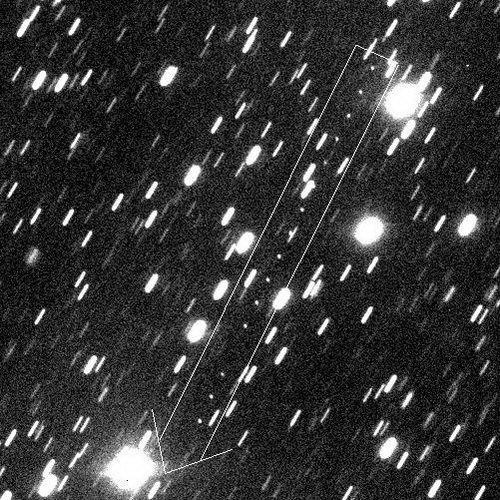2011 MD on:
[Wikipedia]
[Google]
[Amazon]
2011 MD is a bright micro- asteroid, classified as
 Although was initially believed to be
Although was initially believed to be
Encounter animations
(Pasquale Tricarico) * * * {{DEFAULTSORT:2011 MD # # Minor planet object articles (unnumbered) # 20110627 20110622 Near-Earth objects in 2024
near-Earth object
A near-Earth object (NEO) is any small Solar System body whose orbit brings it into proximity with Earth. By convention, a Solar System body is a NEO if its closest approach to the Sun (perihelion) is less than 1.3 astronomical units (AU). ...
of the Apollo
Apollo, grc, Ἀπόλλωνος, Apóllōnos, label=genitive , ; , grc-dor, Ἀπέλλων, Apéllōn, ; grc, Ἀπείλων, Apeílōn, label= Arcadocypriot Greek, ; grc-aeo, Ἄπλουν, Áploun, la, Apollō, la, Apollinis, label ...
and Amor group, respectively. On 27 June 2011, at around 17:00 UTC (13:00 EDT), the object passed exceptionally close to Earth's surface at a distance of approximately , roughly the diameter of the Earth.
Description
 Although was initially believed to be
Although was initially believed to be space junk
Space debris (also known as space junk, space pollution, space waste, space trash, or space garbage) are defunct human-made objects in space—principally in Earth orbit—which no longer serve a useful function. These include derelict spacec ...
, subsequent observations confirmed that it is an asteroid. A few hours before the asteroid's nearest approach in 2011, it appeared close to the Sun, so observations were possible for only a brief period. Backyard astronomers were able to observe it with telescopes from Australia, southern Africa, and the Americas.
was discovered on 22 June 2011, by astronomers of the Lincoln Near-Earth Asteroid Research
The Lincoln Near-Earth Asteroid Research (LINEAR) project is a collaboration of the United States Air Force, NASA, and the Massachusetts Institute of Technology's Lincoln Laboratory for the systematic detection and tracking of near-Earth objects ...
(LINEAR) at the U.S. Lincoln Laboratory Experimental Test Site
The MIT Lincoln Laboratory, located in Lexington, Massachusetts, is a United States Department of Defense federally funded research and development center chartered to apply advanced technology to problems of national security. Research and dev ...
in Socorro, New Mexico, by a pair of robotic telescopes. According to original rough estimates, the asteroid's length was between . However, according to the more recent absolute magnitude
Absolute magnitude () is a measure of the luminosity of a celestial object on an inverse logarithmic astronomical magnitude scale. An object's absolute magnitude is defined to be equal to the apparent magnitude that the object would have if it ...
(H) measurement of 28.1 and its albedo of 0.3, the asteroid is closer to 6 meters or 20 feet in diameter.
Emily Baldwin of ''Astronomy Now
''Astronomy Now'' is a monthly British magazine on astronomy and space. According to the Royal Astronomical Society, ''Astronomy Now'' is the "principal amateur astronomy magazine in Britain" with a reputed circulation of 24,000.
The magazine ...
'' said that there was no threat of collision, and should the asteroid enter Earth's atmosphere
The atmosphere of Earth is the layer of gases, known collectively as air, retained by Earth's gravity that surrounds the planet and forms its planetary atmosphere. The atmosphere of Earth protects life on Earth by creating pressure allowing fo ...
, it would "mostly burn up in a brilliant fireball, possibly scattering a few meteorites", causing no likely harm to life or property on the ground.
The 27 June 2011 close approach to Earth increased the orbital period of from 380 days to 396 days. During close approach the asteroid passed Earth at a relative speed of 6.7 km/s with a geocentric
In astronomy, the geocentric model (also known as geocentrism, often exemplified specifically by the Ptolemaic system) is a superseded description of the Universe with Earth at the center. Under most geocentric models, the Sun, Moon, stars, an ...
eccentricity of 1.1.
was observed by the Spitzer Space Telescope in February 2014 and estimated to be in diameter. The asteroid is a porous
Porosity or void fraction is a measure of the void (i.e. "empty") spaces in a material, and is a fraction of the volume of voids over the total volume, between 0 and 1, or as a percentage between 0% and 100%. Strictly speaking, some tests measure ...
rubble pile
In astronomy, a rubble pile is a celestial body that is not a monolith, consisting instead of numerous pieces of rock that have coalesced under the influence of gravity. Rubble piles have low density because there are large cavities between the ...
with a density similar to water. On 19 June 2014, NASA reported that asteroid was a prime candidate for capture by the Asteroid Redirect Mission (ARM) in the early 2020s.
Gallery
See also
*Asteroid capture
Asteroid capture is an orbital insertion of an asteroid around a larger planetary body. When asteroids, small rocky bodies in space, are captured, they become natural satellites. All asteroids entering Earth's orbit or atmosphere so far have been n ...
* Asteroid Redirect Mission
References
External links
Encounter animations
(Pasquale Tricarico) * * * {{DEFAULTSORT:2011 MD # # Minor planet object articles (unnumbered) # 20110627 20110622 Near-Earth objects in 2024